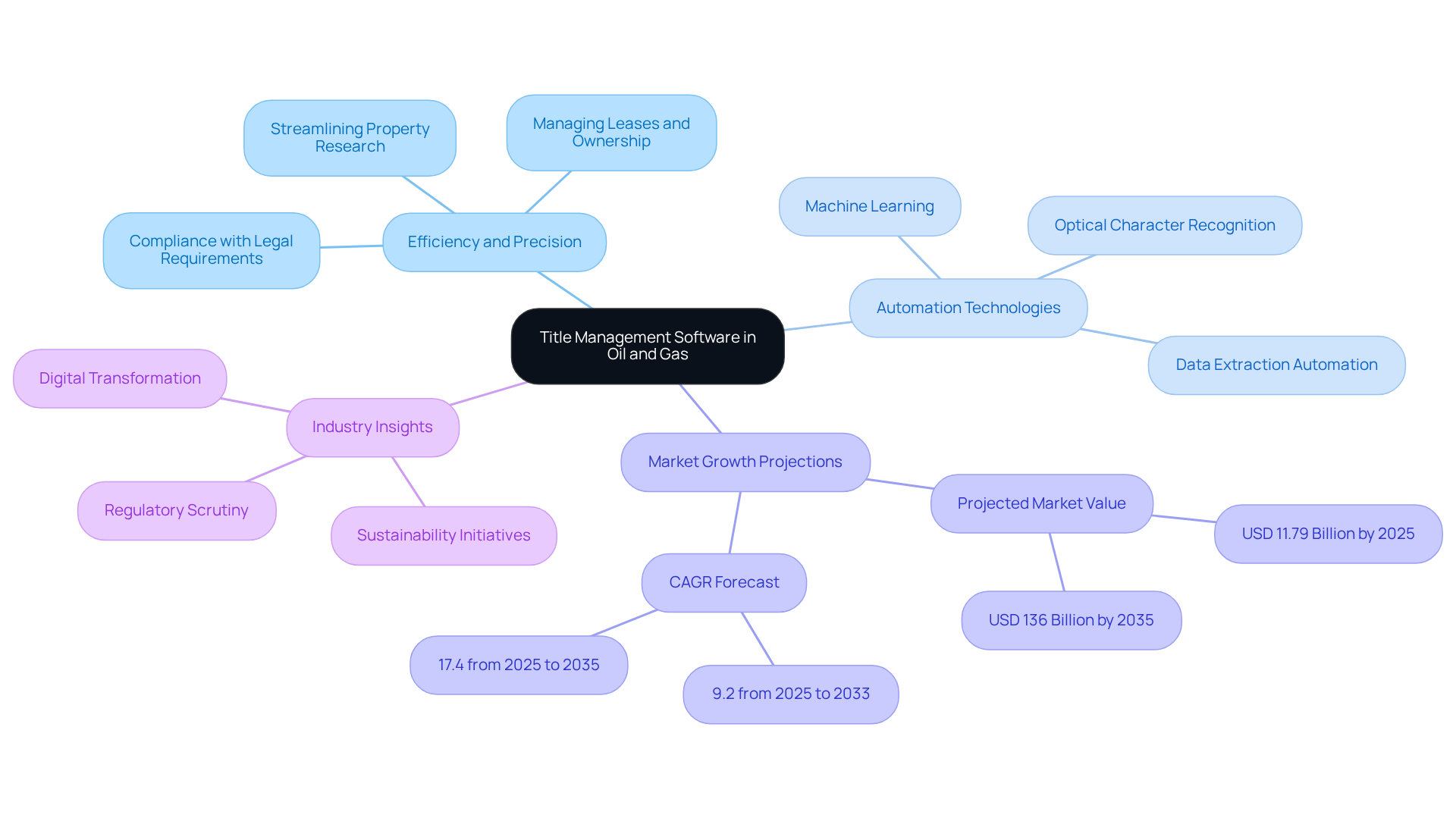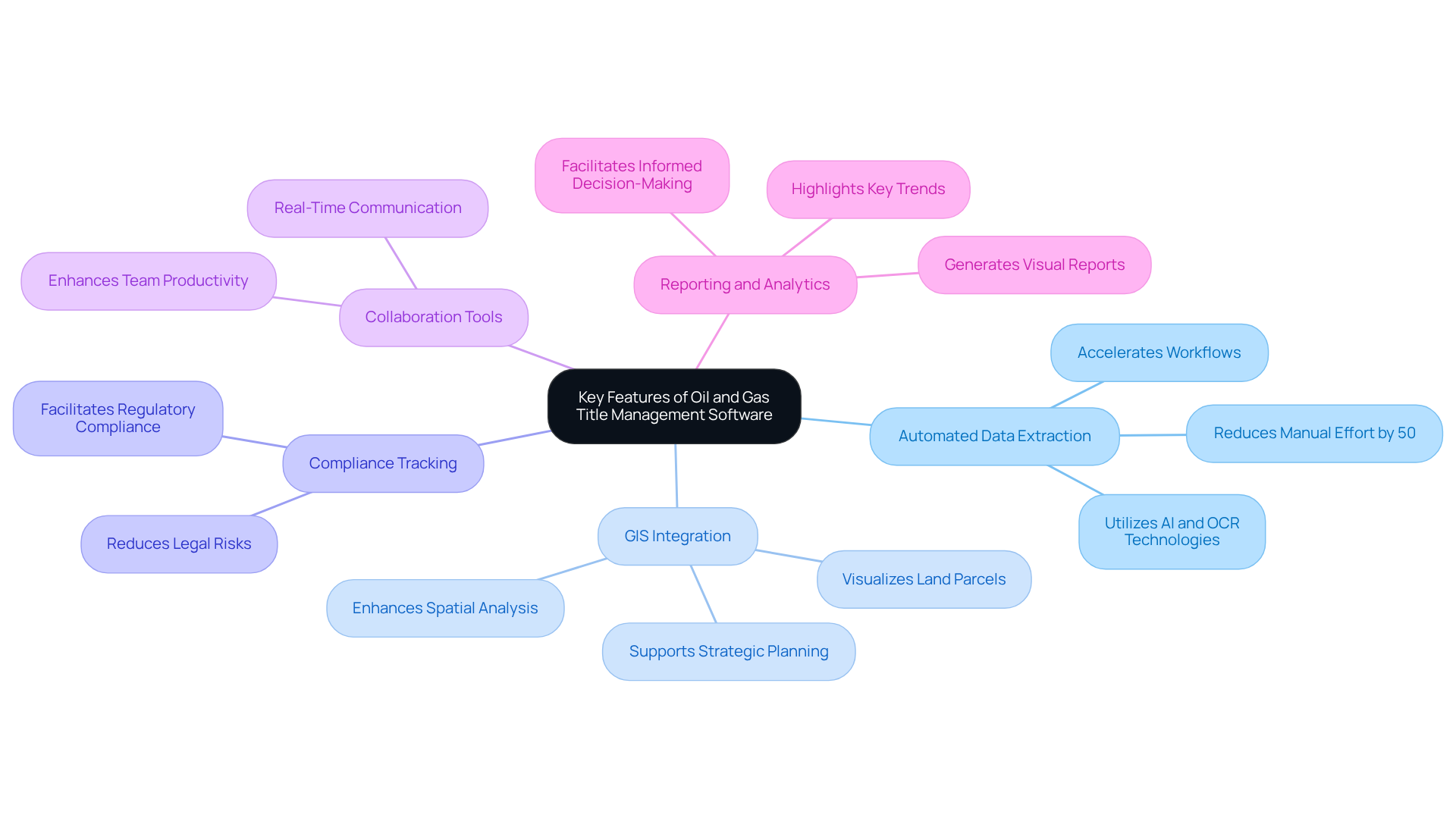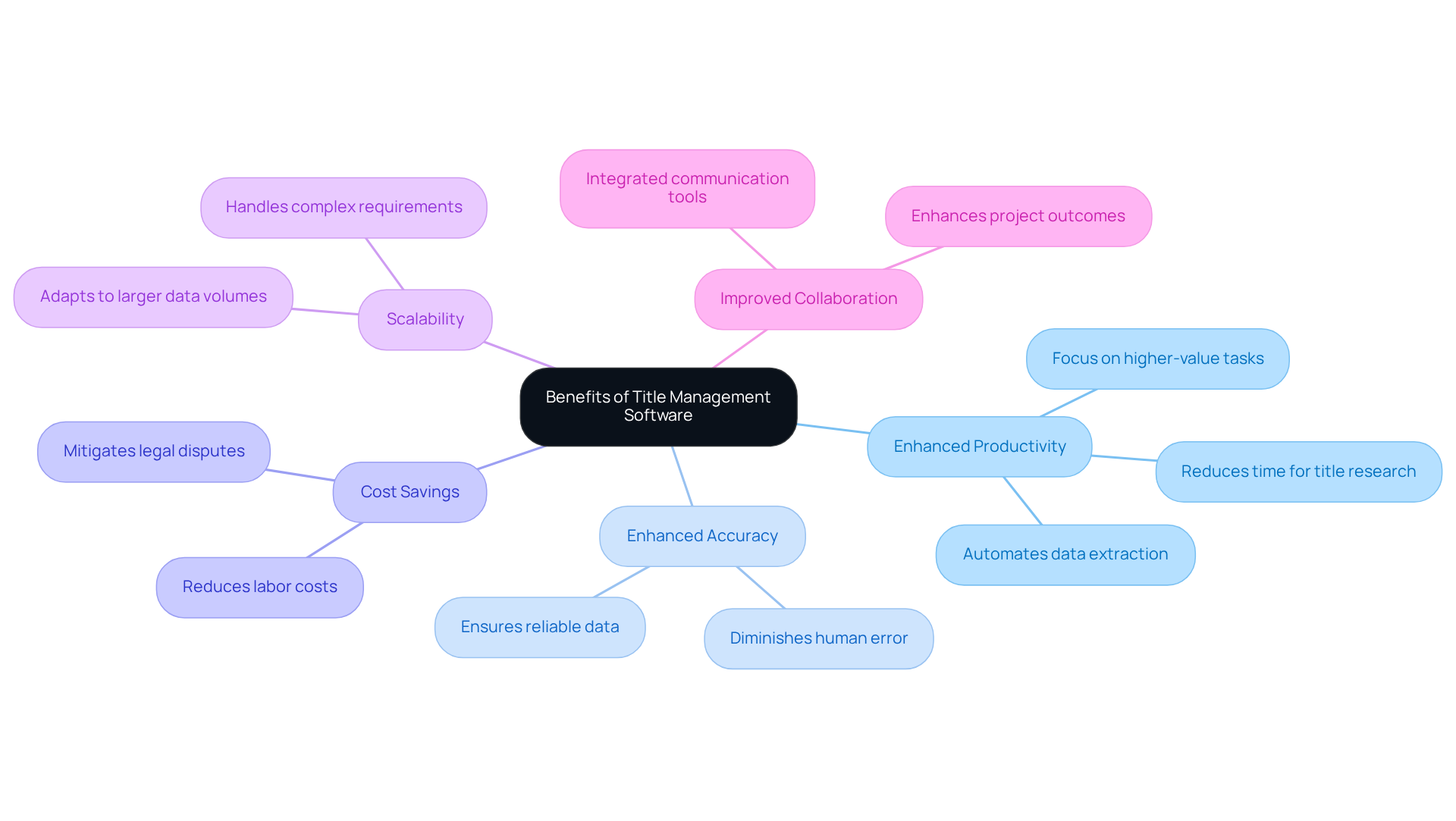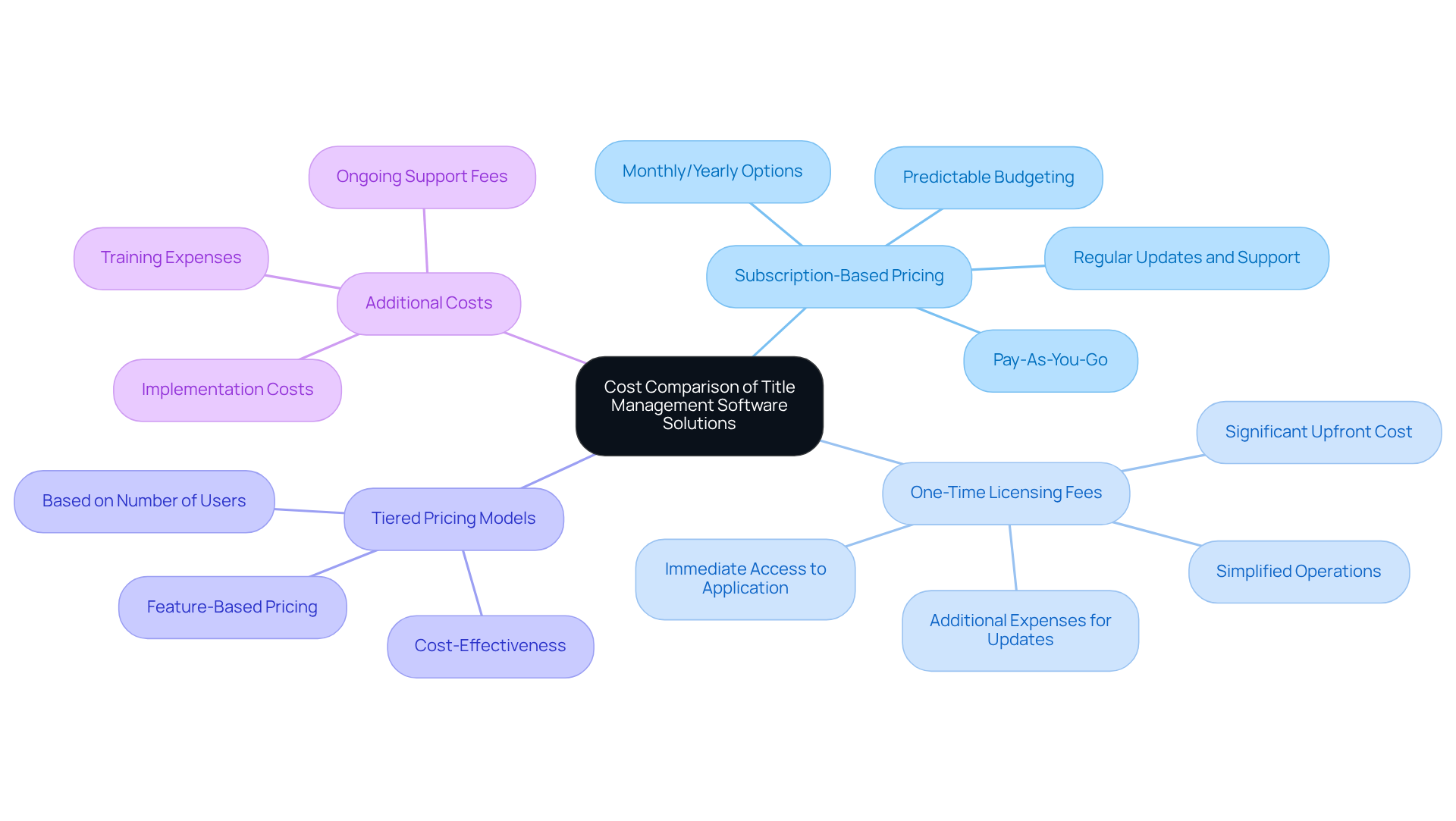Overview
The optimal software for oil and gas title management significantly enhances both efficiency and accuracy in the management of property rights and ownership. This is achieved through features such as:
- Automated data extraction
- GIS integration
- Compliance tracking
Furthermore, the article illustrates how these sophisticated tools streamline complex processes, reduce manual effort, and consequently lead to substantial cost savings and improved productivity within the industry.
Introduction
The oil and gas industry is increasingly reliant on sophisticated technology to navigate the complexities of property management, particularly in title management. As regulatory demands escalate and the necessity for swift, accurate decision-making intensifies, the leading software solutions for oil and gas title management present a transformative opportunity for companies to enhance both efficiency and precision. However, with a plethora of options available, organizations face the challenge of discerning which software will best meet their unique needs while balancing cost and functionality.
Overview of Title Management Software in Oil and Gas
The development of property management applications in the oil and gas industry is driven by a critical demand for the best software for oil and gas title management to enhance efficiency and precision in managing property rights and ownership. These advanced tools are meticulously designed to streamline the complex processes involved in property research, which includes verifying ownership, managing leases, and ensuring compliance with rigorous legal requirements. As the industry faces increasing regulatory scrutiny and the necessity for rapid decision-making, adopting the best software for oil and gas title management has become indispensable.
Furthermore, employing advanced technologies such as machine learning and optical character recognition allows these systems to automate data extraction from document titles, significantly reducing the time and effort typically required for manual research. This transformation not only boosts operational efficiency but also enhances accuracy, positioning it as the best software for oil and gas title management, empowering companies to navigate the complexities of title management with greater assurance.
According to industry forecasts, the global oil and gas technology market is projected to reach USD 11.79 billion by 2025, expanding at a CAGR of 9.2% from 2025 to 2033. This underscores the importance of adopting . Moreover, expert insights indicate that as exploration and extraction efforts shift to more challenging environments, the need for sophisticated technological solutions becomes imperative.
The subsequent sections will delve into specific applications, their key characteristics—including tools such as 'Well Helper' and executive dashboards—and the tangible advantages they offer to the oil and gas sector.

Key Features of Leading Oil and Gas Title Management Software
The best software for oil and gas title management includes leading solutions that incorporate several essential features, significantly enhancing operational efficiency.
- Automated Data Extraction: Utilizing advanced machine learning and optical character recognition technologies, these tools can quickly extract relevant data from extensive documentation. This automation can decrease manual effort by up to 50%, enabling researchers to accelerate their workflows and concentrate on more valuable tasks. According to Gartner research, AI-driven contract analysis can likewise lessen manual effort for contract review by 50%, highlighting the transformative potential of automation in overseeing titles.
- GIS Integration: Geographic Information Systems (GIS) capabilities are crucial for visualizing land parcels and ownership boundaries. This integration not only aids in better decision-making but also , enabling professionals to assess land use and ownership trends effectively. As noted by industry experts, the ability to visualize data spatially is a game-changer for strategic planning in the oil and gas sector.
- Compliance Tracking: Many software solutions are equipped with features that facilitate compliance with local, state, and federal regulations. This functionality is essential for reducing legal risks and ensuring that all ownership administration activities comply with the necessary legal frameworks.
- Collaboration Tools: Integrated communication features foster effective teamwork by allowing users to share insights and updates in real-time. This collaborative environment enhances productivity and ensures that all team members are aligned on project goals.
- Reporting and Analytics: Advanced reporting tools offer valuable insights into data regarding titles, enabling organizations to make informed decisions based on comprehensive analyses. These tools can generate visual reports that highlight key trends and patterns, making complex data more accessible. The importance of visual insights in reporting cannot be overstated, as they facilitate quicker understanding and better decision-making.
The incorporation of these features not only simplifies oversight processes but also enables oil and gas professionals to react promptly to industry changes and regulatory requirements, demonstrating why it is considered the best software for oil and gas title management. Additionally, the oil & gas data handling tools market is expected to expand substantially, attaining USD 136.0 billion by 2035, with a compound annual growth rate (CAGR) of 17.4%. This growth highlights the importance of embracing advanced naming solutions.

Benefits of Using Software for Title Management
The adoption of title management software in the oil and gas industry presents significant advantages:
- Enhanced Productivity: By automating data extraction and oversight processes, these tools drastically reduce the time required to complete title research, allowing professionals to focus on higher-value tasks.
- Enhanced Accuracy: Automated systems significantly diminish human error, ensuring that the data utilized for decision-making remains reliable and current.
- Cost Savings: Organizations can achieve substantial savings on labor costs and mitigate the risk of costly legal disputes by ensuring compliance and precision in ownership oversight.
- Scalability: As businesses grow, these applications can seamlessly adapt to manage larger data volumes and more complex handling requirements.
- Improved Collaboration: Equipped with integrated communication tools, teams can collaborate more effectively, sharing insights and updates that enhance overall project outcomes.
These benefits underscore why constitutes a strategic decision for oil and gas firms aiming to optimize their operations.

Cost Comparison of Title Management Software Solutions
When assessing title management programs, organizations must thoroughly evaluate the cost frameworks linked to different options, as these can greatly influence overall operational effectiveness. The pricing models available can vary widely based on features, scalability, and vendor support. Below are some prevalent pricing models:
- Subscription-Based Pricing: Numerous program providers offer adaptable monthly or yearly subscription options, usually ranging from $50 to $500 per user. This model allows for predictable budgeting and often includes regular updates and support, fostering long-term customer relationships. Furthermore, subscription pricing can improve cash flow forecasting and business planning through predictable recurring revenue. Additionally, some vendors offer a pay-as-you-go option, allowing organizations to acquire documents and process them as needed, which can be beneficial for those with fluctuating demands.
- One-Time Licensing Fees: Certain options require a significant one-time acquisition cost, frequently surpassing $10,000 for complete systems. While this model offers prompt access to the application, it may restrict and necessitate additional expenses for updates and support. One-time payment models eliminate the need for managing recurring billing systems, simplifying operations.
- Tiered Pricing Models: Vendors frequently implement tiered pricing based on the number of users or features required. This approach enables organizations to select a plan that aligns with their specific needs and budget, promoting cost-effectiveness.
- Additional Costs: Organizations should also factor in potential additional expenses for training, implementation, and ongoing support. These costs can accumulate, impacting the overall investment and necessitating careful financial planning.
By thoroughly comparing these costs against the benefits of each solution, organizations can make informed decisions regarding which is the best software for oil and gas title management that meets their operational requirements and financial constraints. This strategic evaluation is crucial for optimizing resource allocation and enhancing overall productivity in the oil and gas sector.

Conclusion
The significance of adopting the best software for oil and gas title management is paramount, fundamentally transforming how industry professionals manage property rights and ownership. By leveraging advanced technologies, these software solutions streamline complex processes, enhance accuracy, and empower organizations to navigate regulatory landscapes with confidence.
Key features such as:
- Automated data extraction
- GIS integration
- Compliance tracking
- Collaboration tools
- Robust reporting capabilities
are essential components driving efficiency in title management. These functionalities not only reduce manual effort and human error but also foster a collaborative environment that enhances overall productivity. Furthermore, the cost analysis of various software options reveals that organizations can select from flexible pricing models that align with their financial strategies while maximizing operational effectiveness.
In a rapidly evolving industry, the integration of sophisticated title management software is not merely a competitive advantage; it is a necessity for sustainable growth. As the oil and gas sector continues to face both challenges and opportunities, investing in these advanced solutions will be crucial for organizations aiming to optimize operations and ensure compliance. Embracing these technologies today will pave the way for a more efficient and resilient future in oil and gas title management.
Frequently Asked Questions
What is the purpose of title management software in the oil and gas industry?
The purpose of title management software in the oil and gas industry is to enhance efficiency and precision in managing property rights and ownership, streamline complex processes involved in property research, and ensure compliance with legal requirements.
How does title management software improve operational efficiency?
Title management software improves operational efficiency by employing advanced technologies such as machine learning and optical character recognition to automate data extraction from document titles, significantly reducing the time and effort required for manual research.
Why is adopting the best software for oil and gas title management becoming indispensable?
Adopting the best software for oil and gas title management is becoming indispensable due to increasing regulatory scrutiny and the necessity for rapid decision-making in the industry.
What is the projected growth of the global oil and gas technology market?
The global oil and gas technology market is projected to reach USD 11.79 billion by 2025, expanding at a CAGR of 9.2% from 2025 to 2033.
What challenges are driving the need for sophisticated technological solutions in oil and gas?
The need for sophisticated technological solutions in oil and gas is driven by the shift of exploration and extraction efforts to more challenging environments.
What specific applications and tools are mentioned in the article related to title management software?
The article mentions tools such as 'Well Helper' and executive dashboards as specific applications related to title management software in the oil and gas sector.
What are the key characteristics of title management software discussed in the article?
The key characteristics of title management software include its ability to streamline property research processes, automate data extraction, and enhance accuracy in managing property rights and ownership.




